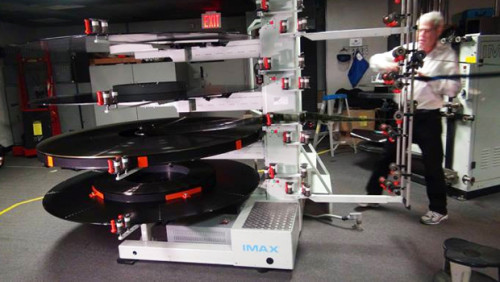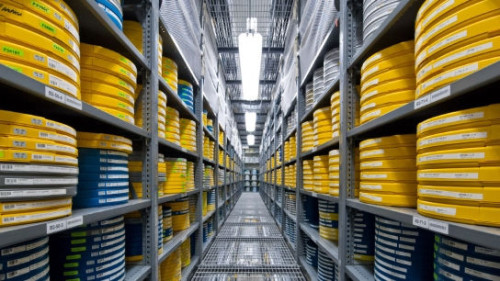The end of celluloid film has been happening steadily over the last few years, with each new blow seemingly the knock-out punch. But its devotees refuse to give up the fight. “If I can’t shoot on film I’ll stop making movies,” said Quentin Tarantino in 2014. He was talking on radio station KCRW’s “The Treatment” in L.A, “The fight is lost if all we have is digital DCP presentations. To me, that’s just television in public.” he added. The DCP he refers to is Digital Cinema Package, the computer hard drive that contains a movie’s audio and video. It is sent to a movie theater where it is ingested into the projector for digital projection. Like reels of film before it, the DCP can be sent on to another theater, only its a lot cheaper for the studio to produce. This is not the latest technology, as many theaters can get their films directly by satellite transmission.

The use of 70 mm film stock in movie-making had already died by the end of the 1960s.That’s when studios used it to pry people away from their TV sets and TV dinners and into theaters to watch movies like South Pacific, Cleopatra, Lawrence of Arabia, and It’s a Mad Mad, Mad Mad World. But like many old movies, 70 mm was ripe for a sequel. Tarantino’s last movie, The Hateful Eight, recently, was shot on 70mm (actually 65mm) film stock. Director Christopher Nolan stated , “I don’t want anyone telling any filmmaker they can’t shoot on film any more than telling David Finch and Steven Soderbergh that they can’t shoot digital. It’s the director’s right. It’s their choice.” Christopher Nolan shot Intersteller in 2014 on 70mm film stock (65mm). Warner Brothers released the movie two days early to those theaters that still had film projectors. The iconic TCL Chinese Theater in Hollywood acquired film projectors for the occasion. Several smaller theater chains that had already converted to digital projection squwaked. “I can’t afford to get the projectors out of the warehouse,” said Joe Paletta of the Spotlight Theaters in Georgia, “and I don’t have anyone to operate them [the film projectors].” For Nolan, it was an opportunity to incentivize and reward the theaters that had kept projecting film.

In 2002 Star Wars Episode: II Attack of the Clones became the first movie to be shot entirely in digital. But now, the latest Star Wars Episode VII: The Force Awakens was shot on 65mm film stock by film proponent J.J. Abrams, with the encouragement of George Lucas. Part of the idea was to recapture the look of the original trilogy. This was important to Lucas because, as Abrams added “… the movie, in a way, goes backwards to go forwards.” George Lucas wants the future episodes to be shot on film also.

Yet the world of film still teeters on the abyss. The new Star Wars was only shown on 70mm film at IMAX theaters . Nearly everywhere else it was projected on a digital transfer. But film’s qualities come in different shapes. For the movie Carol, director Todd Haynes wanted a muted look in the cinematography. This was in keeping with the bleak times in Cold-War New York during 1952 when the story took place. The story was based on the novel by Patricia Highsmith. Haynes and his team including cinematographer Ed Lachman referenced the work of women photographers of the time: Ruth Orkin; Helen Leavitt; and Vivian Maier. They were especially intrigued by the photographers’ use of Kodak Ektachrome film and its muted colors, and wanted to achieve that look. This meant shooting on film rather than digitally. And more unusually, Ed Lachman used Super 16mm. His reasoning was that if he used 35mm, by the time it was converted for digital projection there would be no difference in the finished look – the “grain” would have all disappeared. “The feeling and texture of the grain reinforced the emotionality of the story,” said Lachman.
But the world of film still teeters on the abyss. In New York, Technicolor and Deluxe, long-time processors of color film for the movie industry, had been amalgamated as the Film Lab New York. After processing Carol the Lab went belly-up. After Ed Lachman found out that the lab equipment was going to be tossed, he made arrangements to salvage it all. Technicolor had already closed a plant in Glendale California.
Yet digital cinema, the current master of moviedom, is showing signs of the panic that befell the Hollywood studios in the late 1950s and 1960s. Recently we were given 3-D movies, a trend already showing signs of fatigue. Then we were offered dining and wine with our cinema, and reserved seating. Reclining seats are the next trend, with news of the introduction of sensory enhancements like vibrating seats and the diffusion of smells (didn’t Smell-O-Vision come out in the 1950s too?). Perhaps the thinking is that bombarding the senses with smells, booming sounds, vibrating seats, and explosions on the screen will get us all into the theaters.
It’s a rarely disseminated fact that movie attendance has been nose-diving steadily and surly since 1930. Back then, 80 million people, or 65% of the U.S. population, went to the movies a week. In 2015, that number has dropped to 25.7 million people a week, less than 10% of the U.S. population. A yearly chart, covering 1930-2000 can be found here. The attendance numbers have continued to drop since 2000. Back in the 1930s, to lure all those movie-goers, each of the seven big studios released 30 to 40 films a year. But we know that The U.S Courts broke up the studio-system in its Anti-Trust ruling in 1948, forcing them to sell of their movie theaters. How laughable with the multi-media, multi-national, corporate conglomerates we now have running movie studios.

In 2015, in a busy year for the busiest studio Warner Brothers, it released 21 movies. Movie revenues are freely quoted, which seem very impressive, and is helped by the always escalating prices for theater tickets. While this has nothing to do with whether or not a movie is film-based or digital, it is connected to movie industry economics – which brought us digital based film projection. And of course, as Kenneth Turan the film critic of the LA Times said in writing about Hollywood, “The one big thing it knows how to make is sequels and superhero movies and sequels to superhero movies.”
But which medium is best for the preservation of the content, one might wonder? It seems intuitive that digital is best as a preservation medium. And certainly that’s what we have been hearing for the last several years. But Martin Scorsese doesn’t think so. “Film is still the only preservation medium that we know to be durable.,” he said. “We just don’t know about digital storage systems. They haven’t been around long enough, and more importantly, they’re always changing. I think it’s important t to preserve our pictures on film, no matter how we shot them or finished them. That means negatives, and it means prints.” Mr. Scorsese is the founder of the Film Foundation, whose mission it is to preserve movies. Of course film has had a very rocky history. Approximately 90% of American silent films are considered lost, as well as 50% of sound films made before 1950. The combustible nitrate-based film of the silent era is partly responsible, leading to major fires at studio vaults. M-G-M had an electrical fire in 1967, destroying most of the studio’s cartoons, silent films, and films from the earlier Metro, Goldwyn, and Louis B. Mayer Pictures. Similarly, a fire at Fox Pictures destroyed its pre-1935 film negatives. Huge efforts have been made to preserve older films and newer ones since, but the job is colossal.


This blog post is disseminated digitally. Part I appeared in February 2014.
Views: 197

